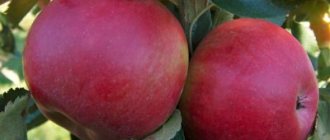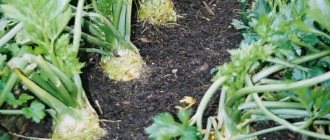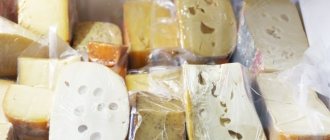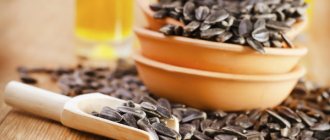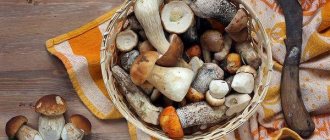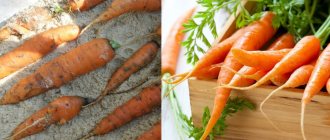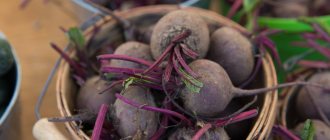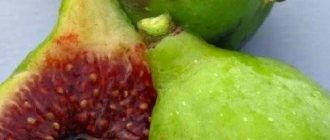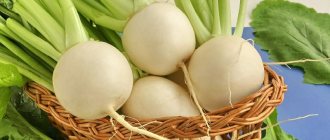Carrots and beets have long and firmly taken their place on our table. Without them, it is impossible to imagine either a holiday table with the famous herring under a fur coat, or a weekday with beetroot or vinaigrette. Harvesting according to the rules is only half the success. The second half is to keep everything safe and sound until the next harvest. Do not forget that only properly sown root crops that have been carefully cared for are stored well.
Carrots and beets are classified as root vegetables. They have a two-year development cycle. In the first year of life, plants form a basal rosette of leaves and a succulent root crop, which stores organic and nutrients. Root vegetables are important in nutrition and have the ability to be stored for a long time in winter and spring without reducing their nutritional value and vitamin composition.
Suitable varieties
Late-ripening varieties of root crops should be selected for storage . The following varieties and hybrids of carrots are best stored:
Gribovchanin F1.- Nantes 4.
- Incomparable.
- Nevis F1.
- Samson.
- Chance.
- Moscow winter.
- Incomparable.
Beet varieties suitable for long-term storage:
- Bravo.
- Incomparable.
- Bordeaux 237.
- Red ball.
- Podzimnyaya.
- Mulatto.
- Detroit.
- Nosovskaya flat.
There are no definite recommendations on how best to store it at home and where, in the basement or underground (underground), everyone decides for themselves experimentally. The determining factors for further preservation are:
- choice of root crop variety;
- preparation technology;
- room temperature;
- humidity mode;
- lack of excess oxygen supply;
- pest protection.
Among the storage methods, every gardener will find his own, the most convenient and profitable. First, you need to decide when and how to remove root crops for storage .
You can read more about suitable varieties of carrots and shelf life here, and here we talked about which varieties are suitable for long-term storage.
How to preserve carrots for the winter
Compared to beets, carrots are more demanding on storage conditions: they are more susceptible to mechanical damage and retain moisture less well. Root crops quickly wither and germinate even with a slight increase in temperature in the cellar. Carrots are placed in storage at a temperature of 0-2°C and high humidity so that the root vegetables remain juicy for as long as possible.
The most popular ways to store carrots
- Recently, storing carrots in plastic bags has become widespread. Up to 5 kg of root vegetables are poured into them and tied tightly.
- You can also leave carrots for the winter in bags with a capacity of up to 20 kg. In this case, it is advisable to sprinkle an 8-10 cm layer of wet sawdust on top of the root vegetables.
- It is very popular to store carrots in sand: pour a 2 cm layer of sand on the bottom of the box, put root vegetables in it and sprinkle them with a 1 cm thick layer of sand. After which the manipulations are repeated. Please note that with such a layered arrangement, the root vegetables should not touch.
The following varieties and hybrids of carrots are best stored in winter: Gribovchanin F1, Monanta, Canada F1, Mango F1, Nanteiska, Nandrin F1, Nantesskaya 4, Incomparable, Nevis F1, Nerak F1, Rosal, Samson, Typhoon, Tsirano, Chance, Valeria, Moskovskaya winter, etc.
- The best varieties of carrots for winter storage
What varieties of carrots will be stored all winter?
However, we should not forget that only properly sown root crops, which were carefully cared for during the growing season and protected from diseases and pests, are well stored.
When is the best time to dig up vegetables?
Harvesting vegetables too early reduces the consumer quality of the root vegetable, preventing it from accumulating a sufficient amount of sugars.
Staying in the garden for too long makes it possible to accumulate sugar in large quantities, which makes the vegetable very attractive to rodents. Typically, harvesting times depend on the ripening period and weather. The ripening period of root crops is usually written on the seed packaging . It is better to dig up vegetables for storage when it is favorable according to the Lunar calendar. The days of the waning moon are considered the most favorable, but this factor can be neglected for the sake of suitable weather conditions.
Harvesting should begin at the time when the lower 2-3 shoots of the tops have turned yellow. Such root vegetables already have good consumer properties. We harvest beets before the first frost (having frozen, they will not be suitable for storage), and carrots can be safely left in the garden until the first snow (chilled root vegetables are better stored). In a rainy autumn, it is better to harvest the crops early, since the roots, saturated with moisture, will not be preserved well until spring and will be more susceptible to rotting.
You can learn about when to remove carrots from the garden for storage here.
Watch a video about the timing of harvesting carrots and beets:
Harvesting methods
Someone pulls root crops out of the ground, someone digs with a pitchfork, someone takes up a shovel. How to do it right? Do not water the vegetable bed before harvesting .
It is best to dig with a blunt pitchfork, supporting the root crop by the tail. The forks must be placed strictly vertically no closer than 5 cm from the row. This will help avoid microtraumas, because the key to good storage is intact skin. Therefore, hitting root vegetables against each other to shake off the soil is also not recommended.
It is better to remove excess soil from root crops with gloved hands . Then you need to trim the tops, cut them, not break them off, leave a tail of 1-1.5 cm, and leave to dry for several hours. Tops should be trimmed immediately as this will preserve nutrients. Then sort the fruits, remove damaged and spoiled roots to avoid rot.
Some vegetable growers recommend this method of cutting carrot tops - cutting off 0.5–1 cm of the top of the root crop itself. If you use this method, you should keep the vegetables for some time before storing them in the storage place - until the top cut is covered with a crust, otherwise the fruits will begin to rot soon. In rainy weather, drying in the shed may take several days, even a week.
Root crops must not be washed before storing ! Washed beets and carrots can be stored in the vegetable compartment of the refrigerator in a plastic bag for one month.
Where and how can you keep them fresh at home?
You can store it at home (in an apartment), either on a glazed balcony, cellar (basement), or in a garden bed. But the best place to store vegetables is undoubtedly the cellar . It is always dark there, constant temperature and humidity are maintained.
You need to prepare the cellar in advance. Ventilate, if necessary, dry, treat against fungus, check for holes from rodents. To reduce humidity, you can place boxes of salt or charcoal in the corners of the cellar. If you whitewash the basement walls with quicklime, you can kill two birds with one stone: the lime will both disinfect and make the air drier.
What temperature and humidity should it be?
At temperatures close to zero, metabolism rapidly slows down, which contributes to greater preservation of root crops. They have no rest period. The storage temperature of carrots and beets should not be more than 10 degrees , because already at +5 degrees, buds that could not be completely removed can begin to grow.
If the humidity is low, it threatens withering of the root crops; if it is high, it is fraught with rotting. Therefore, humidity should be maintained around 85 – 90%.
You can read more about the required storage temperature in this article.
What varieties can be stored?
Early and mid-ripening varieties of short length do not retain moisture well, so they are not suitable for long-term storage. Use them before the onset of cold weather or preserve them.
For long-term preservation, choose late-ripening carrot varieties whose fruit length is at least 20 cm. These are:
Forto.- Valeria.
- Vita Longa.
- Moscow winter.
- Berlicum.
- Nuance.
- Queen of Autumn.
- Carlena.
- Flaccoro.
- Samson.
- Shantanay.
Read about which varieties of carrots are suitable for long-term storage for the winter in this article.
Options
Beetroot is the most shelf-stable root vegetable. Therefore, the following storage rules should be observed:
- Place them in bins or boxes; at a temperature of about 3 degrees, they will last well in the basement all winter.
- It is well stored on piles of potatoes, which share excess moisture with it.
- In a box without holes, sprinkled with wet sand in the basement.
- In plastic bags of 15-20 kg.
- In the garden in small piles. To do this, dig a hole 40 cm deep, place root crops there in the shape of a prism (prism height 1-1.3 m), cover with a thick layer of straw so that the height of the pile is 2 m, cover with earth, and in winter additionally cover with snow. Before laying, it is advisable to treat with chalk powder (200 g of chalk per 10 kg of beets).
Carrots are difficult to keep in perfect condition because they have a thin skin that does not retain moisture well; the roots quickly dehydrate and dry out. Plastic bags with a capacity of 20-30 kg will help preserve the necessary moisture. Root vegetables are filled in 2/3 of them, sawdust is sprinkled on top, there is no need to tie the bags so that condensation does not form.
The “clay shirt” also preserves carrots well - make a clay mash (clay is diluted in half with water), dip the carrots into this mash and dry it. In such a shirt, carrots retain their juiciness well and do not spoil.
How to properly store for the winter?
Carrots can be stored in several ways:
drying carrots at home;- freezing;
- drying;
- canning.
These are labor-intensive methods, but they are used more often because they better preserve all the nutritional properties of vegetables in the winter. Freezing carrots is also used, when small root vegetables are grated and placed in the freezer. You can show your imagination and make curly cuts. A cheerful mix of vegetables (carrots, sweet peppers, green peas) will also please you in the cold winter.
Avoid storing root vegetables and apples in the same room, this will help preserve the root vegetables longer.
Harvesting beets and carrots is a troublesome task, and it should be approached responsibly . If you do everything on time and follow these simple storage rules, then your vegetables from the garden will be fresh until spring, and maybe until the next harvest year.
If you find an error, please select a piece of text and press Ctrl+Enter.
Temperature and humidity are the main indicators of the shelf life of vegetables. At home they can lie from 2 to 7 months. If optimal conditions are created, carrots and beets can be stored for a year without losing their nutritional and chemical values.
Conservation technologies in the cellar
You can use the following methods:
- In a wooden box . Place the root vegetables in a wooden box equipped with a lid. Cover it and install it in the cellar at a distance of 10-15 cm from the wall. The fact is that the walls can become damp, and then moisture will not get into the drawers. It is not recommended to place boxes on the floor; it is best to use a low stand. Place no more than 20 kg of carrots in one box.
- In chalk solution . Dilute chalk with water to obtain a liquid homogeneous solution, dip each root vegetable into the solution and dry. Place the finished specimens in a box and place it in a cool room. You can use chalk in other ways. Dust the fruits with dry powder. For 10 kg of root vegetables you will need 200 g of chalk. Due to the alkaline properties of chalk, the proliferation of microorganisms stops.
Find out how to store carrots in the cellar here.
General rules for storing root vegetables
Conditions optimal for long-term storage of root vegetables vary depending on their type. However, there are general rules:
| Purity | Before storing vegetables, you need to disinfect the room and containers in which root vegetables will be stored. The walls of the vegetable storehouse should be whitewashed, covered with lime or treated with a sulfur bomb. |
| Constant temperature | In the vegetable storehouse, eliminate the possibility of temperature changes using additional thermal insulation. Optimal – 0–+2°С. Deviation to one side or the other will result in spoilage of vegetables. |
| Preparing root vegetables | Before storing, all vegetables need to be prepared: sorted, cut off the tops, and dried. |
| Regular control | It is necessary to monitor the condition of vegetables throughout the entire storage period. Root crops that show signs of spoilage are subject to confiscation. Rotting from one will spread to all nearby ones. |
Proper storage of carrots at home
Preserving carrots in winter means preserving their appearance, taste and beneficial properties.
Carrots can be stored for quite a long time:
| In a plastic bag | 3 to 4 months |
| In a box without filler | 7 months |
| In a box with wet sand | 9 months |
| In a box with sawdust, chalk, clay | 12 months |
This period is possible if you follow the basic storage rules:
- Late-ripening varieties of carrots are stored for a long time: Queen of Autumn, Flaccoro, Vita Longa, Carlena. Their ripening period is 120–140 days. Some mid-season varieties also store well.
- Dig carrots in late September - early October. By this time, it will ripen well and be prepared for winter storage.
- Before laying, dry the root vegetables in the shade, avoiding heating.
- Immediately after digging, remove the greens. If this is not done, the tops will begin to draw nutrients from the root crop. Use a knife to cut 2 mm above the carrot head. Powder the cut area with chalk to protect it from fungi.
- For storage, large root crops are selected, without skin defects and without signs of disease.
- Carrot storage temperature is from 0 to +2°C. When it decreases, the root crop freezes and after thawing it will become soft, cracked, and unsuitable for eating. When it increases, there is a risk of rot and mold.
- Humidity in the storage is maintained close to 97%. At this level, carrots remain fresh for a long time.
How to store beets in winter?
It is optimal to store beets (otherwise known as beets) in winter in a cellar or pit.
In this case, the following conditions must be met:
- regular temperature range from 0 to +2 °C;
- air humidity from 90 to 92%;
- natural ventilation.
The temperature in the storage should not drop below 0, since frozen beets will not be stored. With warming, the tops will begin to sprout, and because of this, the root crop will wither and lose some of its nutrients.
Beets and carrots are root crops that have excellent shelf life if the variety is chosen correctly and the correct algorithm for growing and harvesting agricultural technology is used.
However, even this does not negate the fact that in order to successfully preserve them, it is necessary to follow certain rules, which are based on the requirements for storage conditions of these crops.
Attention to microclimate
– How is the harvest transported to the cellar (if it is not at the dacha)?
– Boxes, baskets, and buckets are suitable for these purposes, where they are carefully placed (not thrown) to avoid damage to the delicate outer skin. It is also permissible to export it in bags, the main thing is not to shake the products intended for storage.
Click to enlarge
– What should be the temperature and humidity conditions in the cellar? Can these settings be adjusted?
– To store carrots and beets, maintain the temperature at +1...+3°C throughout the entire storage period. Humidity should be at least 95–98%. Cellar ventilation is required: it must be equipped with built-in pipes through which air exchange takes place. Regulate the temperature by opening and closing ventilation structures, and regulate the humidity by placing containers of water in the cellar or by spraying the ceiling, walls and floor with water.
Preparing root vegetables for storage
The first thing you should take care of before wondering how to properly store carrots and beets in the cellar is timely harvesting.
Beetroot is a root crop that does not tolerate frost, so harvesting of this crop should be organized before frost begins, that is, in the third ten days of September - early October. For the southern regions, this period shifts by about 2-3 weeks (that is, cleaning there can be recommended to be carried out throughout October, adjusted for weather problems).
You need to choose a moderately warm sunny day so that the root vegetables have time to dry in the fresh air during this day. Thick roots of beets need to be trimmed with scissors or pruning shears, leaving no more than 1.5–2 cm in length, as well as green tops.
Carrots are ready for harvesting the moment they stop growing. This occurs when the ambient temperature drops to +4 °C.
If you harvest carrots for storage earlier, in a warmer time, there is a sharp temperature change - from warm, sun-warmed soil to a colder air environment, the quality of the crop will sharply decrease, you may lose some of the root crops: they may lose density and hardness and, accordingly, will not be saved.
Tips and prohibitions
To prevent the harvest from spoiling, it is necessary to take into account some nuances . They relate to harvesting, creating conditions in the cellar, and proper preparation of storage and vegetables.
Before storing the products, the cellar must be prepared. To do this, it is ventilated, dried, and treated with fungicidal preparations.
Experts recommend storing mid- and late-ripening varieties for long-term storage:
| Variety/Vegetable | Carrot | Beet |
| Late ripening | Queen of Autumn, Red Giant, Vita Longa, Emperor | Renova, Gribovskaya, Incomparable, Egyptian flat |
| Mid-season | Nantskaya-4, Samson, Nectar F1, Moscow winter | Bohemia, Top Hat, Opolskaya, Patrick |
Another factor that affects the safety of vegetables is the harvest time. It is most optimal to dig up root crops in late September - early October.
A guideline for a successful harvest period can be 2-3 yellowed lower leaves in the tops. Be sure to choose a dry day for cleaning.
There are several taboos that are worth remembering when planting and storing carrots and beets underground. In particular, it is strictly not recommended:
Harvest in rainy weather.- Wash vegetables before placing in containers.
- Place undried root vegetables.
- Leave rotten specimens in the cellar.
- Keep the storage temperature above +5 degrees.
- Keep root vegetables and apples in the same room.
Preparing the storage room
To successfully preserve beets and carrots for a long period, it is necessary to create the following environmental conditions:
- The room temperature should vary between 0 °C and – 2 °C.
- The air humidity in the room should be 80–90%.
- Sufficient air exchange, that is, the presence of proper ventilation.
The combination of these two indicators is extremely important, however, that is not all. The main reason for the spoilage of beets and carrots during storage is the presence of pathogenic microorganisms in the room that can completely destroy the root crops. To prevent such an outcome, it is necessary to carry out sanitary cleaning of the premises before storing the crop for storage.
The first thing to do is to clear the space of unnecessary objects and debris, then you should whitewash the walls with bleach to sterilize the space. This maneuver will get rid of harmful microorganisms that can damage beets and carrots stored for storage.
Selecting a Storage Capacity
Depending on what containers are available and convenient to you, which ones will hold the entire crop, and how long you plan to store it, you can use wooden boxes, plastic and plywood boxes, bags, thick wicker baskets or even plastic bags. Which of these is most suitable for storing carrots and beets? Any option is good, choose what is more comfortable and convenient for you to use.
If there is no need for long-term storage, and you plan to eat vegetables in the near future, it is quite possible to store beets and carrots in a dry vegetable drawer in the refrigerator.
Add a comment Cancel reply
You must be logged in to post a comment.
Autumn has arrived, everything has already grown in the garden, and it’s time to harvest. Preserving the crop correctly, with minimal losses, is no less important than growing it.
The storage must be dried and disinfected in advance.
Potato
The preservation of potatoes is also affected by how they were harvested. It is better to remove the potato tops first, even before harvesting the potatoes. Potatoes must be dried before storing in the cellar. It is advisable to green the seed. This should be done in the sun for 7 days. Sort carefully; do not store diseased or damaged tubers.
The best conditions for storing potatoes are 2–3°C, with an air humidity of 85–90%. To create such conditions, it is necessary to have a dry, cool, dark room, such as a cellar or basement, that does not freeze in winter. Before storing in the cellar, the potatoes need to be thoroughly dried by keeping them in the air for several hours. Potatoes are poured into bins in a layer no higher than 1.5 m.
It is better to store seed potatoes separately.
Plants that secrete phytoncides: wormwood, gooseberry, red rowan leaves (dry) - can be put with potatoes; they prevent rotting.
Potatoes become sweaty during storage; to avoid this, you can sprinkle them with ash, sawdust, or put a layer of beets on top of the potatoes. During storage, beets will take away some of the moisture from the potatoes. Carrots and cabbage should not come into contact with potatoes, as they have a bad effect on their preservation. To reduce humidity, you can place boxes with salt and ash in the cellar.
To prevent early germination, top the potatoes with dry mint.
Carrot
Carrots should be stored at a temperature of +1-3 °C, humidity – 90-95%.
How carrots are preserved also depends on how they were grown. You should not overfeed with nitrogen fertilizers, especially at the end of the season, but fertilizing with ash (phosphorus, potassium) is beneficial.
It is better to harvest carrots in dry weather.
Under no circumstances should carrots be allowed to freeze; outwardly they will look as usual, but after a while they will rot.
Early varieties should be stored separately from late ones.
When storing carrots, they must be dried and sorted. Trim only the tops; the ends cannot be trimmed.
Methods for storing beets and carrots
There are several ways to store beets and carrots in the cellar, each of them has its own advantages, but in terms of effectiveness they are in equal positions, so when choosing, focus on what will be more accessible and convenient for you.
Storage in sand
To prevent root vegetables from drying out, losing turgor and rotting, the containers in which they are stored are filled with sand to a depth of several centimeters, then a layer of carrots or beets is laid, which is again filled with sand. It allows you to retain moisture in root crops and protects them from mechanical damage. It is best to choose fine river sand for these purposes.
Storage in sawdust
An excellent material for storing beets and carrots is sawdust: the bottom of the container is covered with a layer of sawdust about 5 cm thick, then the root vegetables are laid out, which are again covered with a layer of sawdust until the container is filled to the brim.
A layer of sawdust prevents the root vegetables from coming into contact with each other, so if one of them begins to rot, it will not immediately and spontaneously spread to neighboring vegetables.
Shared storage
Is it possible to store carrots and beets together? This is a very popular question among summer residents. Here it is worth making a few clarifications: of course, it is possible to store them in the same room, because both of these vegetables require the same storage conditions, so there will be no harm from such proximity.
However, if we are talking about storing beets and carrots together in one container, you should refrain, or make sure that the root vegetables do not touch under any circumstances. It is worth mentioning that when carrots and beets are stored together, the shelf life of both is significantly reduced, and the potential shelf life is reduced.
Can it be stored together?
Orange and burgundy root crops have similar requirements for winter storage. They have the same required level of temperature and humidity. Harvesting of these crops also occurs at the same time.
Both varieties of vegetables winter well in:
- sand,
- sawdust,
- clay,
- onion peel,
- peat
This allows you to leave carrots and beets in the same cellar until spring, even in the same container.
Despite such similar characteristics, root vegetables have some differences. Beets are considered a more shelf-stable crop, carrots – more capricious.
That is why ideally these vegetables are kept separately . If this is not possible, then placing them in one box, it is necessary to separate the cultures with a layer of filler.
It is not recommended to place carrots and beets close to each other. At the same time, being together in the same cellar does not affect the quality of both vegetables.
Shelf life of carrots and beets
The shortest shelf life will be for those vegetables that are stored in the apartment in the kitchen or in the refrigerator; thus, vegetables can be preserved for up to a month.
When stored in sand or sawdust in special boxes at room temperature, root vegetables can retain their taste and aesthetic qualities for four to five months.
Storage in sand and sawdust in a cellar, basement or on a cold terrace is possible until the new harvest.
There are many ways and options for storing beets and carrots in the cellar. Choose the one that is convenient for you and does not require additional material or time investments. Affordable and simple just for you and the volume of harvest you want to save.
Storage on the balcony
Not everyone has a cellar, so carrots have to be stored in the apartment. A good place for storage is a glass balcony.
In boxes
You can store vegetables in boxes, sprinkled with sand or sawdust in the same way as when storing in a cellar. If it is cool enough on the balcony, then the root vegetables should be placed in boxes and covered with an old blanket or thick cloth.
The shelf life of vegetables on the balcony in boxes is up to six months.
In paraffin
The use of paraffin guarantees the preservation of carrots for up to 4 months. Vegetables should be washed and dried first. Paraffin must be heated until the consistency becomes liquid. Each root vegetable must be dipped into this mass. Carrots with a frozen paraffin layer can be placed in small boxes.
